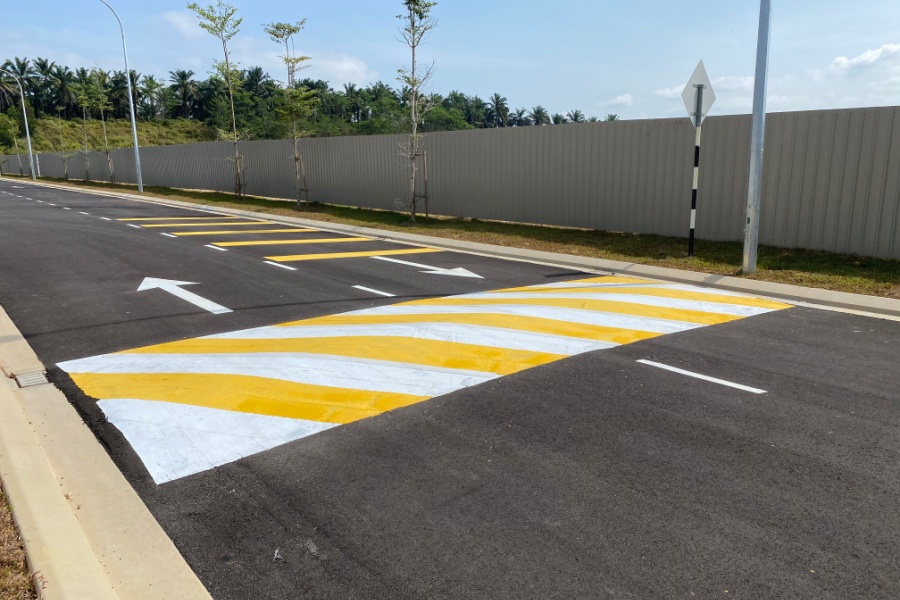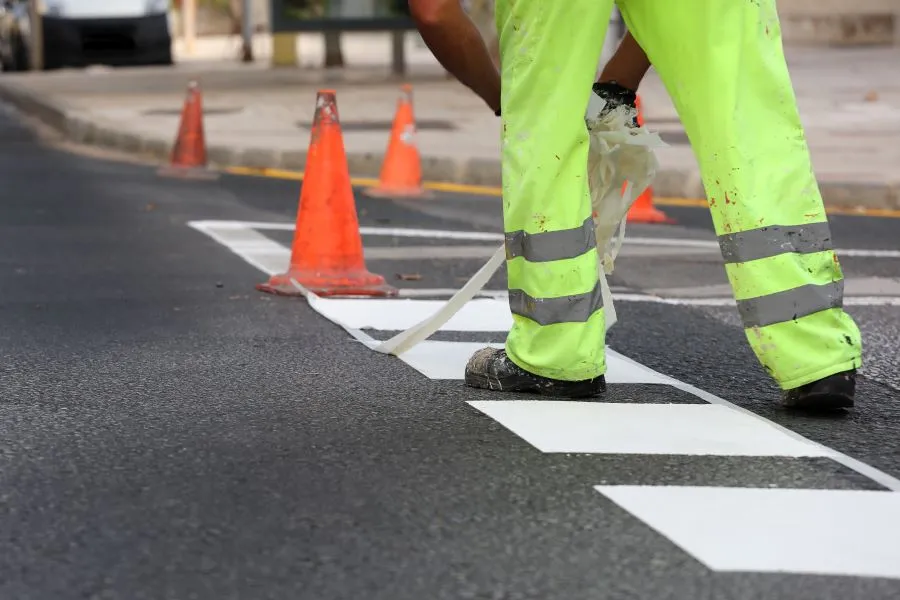Whether it’s beautifying spaces, protecting surfaces, or communicating vital information, the type of paint used plays a critical role in achieving the desired outcome. There’s regular paint that’s used in houses and buildings, and then there’s thermoplastic paint for road markings.
Differentiating Thermoplastic vs. Conventional Paint
Different types of paint are formulated for specific purposes. While regular paint is designed for walls, furniture, or other surfaces within controlled environments, thermoplastic paint for road markings must perform in demanding, outdoor conditions. Let’s dive into the distinctive features of these two types of paint.

Application
Thermoplastic road marking paint is used to create traffic lines, symbols, and road safety markings on various road surfaces. Unlike regular paint, road paint requires a higher degree of control during application to meet regulatory standards for consistency and accuracy. So, it must be applied using specialized equipment handled by trained professionals.
On the other hand, regular paint is used for the interiors and/or exteriors of houses and commercial buildings. There are different types of paint for various building materials, such as cement, wood, and metal. In terms of application, regular paint can be applied using brushes, rollers, or sprayers.
Composition
Road paint contains unique ingredients that enhance its durability and visibility, even in low-light or adverse weather conditions. Some road paint is made with thermoplastics, resin, and reflective glass beads. It also contains additives like anti-slip agents to improve road safety.
The composition of regular paint typically includes pigments, binders, solvents, and additives. While these components enhance color and finish, they lack the specialized features, such as reflectivity or durability, found in road paint. Regular paint is not designed to handle heavy wear or outdoor exposure.
Drying Time
Most thermoplastic road marking paint is designed to dry and set quickly, depending on the temperature and humidity conditions. Minimal drying time means a shorter time needed to work on the road paint application. This minimizes disruptions to traffic flow, as motorists can use the road immediately.
The drying time of regular paint is typically longer. There are also quick-drying regular paints, but most take at least an hour to cure fully. Drying time depends on the type of paint (e.g., oil-based or water-based) and environmental factors, making it less predictable than thermoplastic paint for road marking.
Aesthetics
A significant difference between regular paint and thermoplastic paint is the latter’s focus on functionality over aesthetics. Road paint comes in limited colors, such as white, yellow, and red. These colors offer high contrast and visibility, which is why they’re typically used in traffic signs.
Besides the color, traffic paint comes in a matte or semi-gloss finish, which reduces glare and improves legibility at night and in low-visibility conditions. This helps pavement markings serve their purpose, regardless of the weather.
Meanwhile, regular paint offers a wide range of finishes, from matte to high-gloss, and an extensive palette of colors. Regular paint is not concerned with visibility. It is tailored mainly for aesthetic purposes, allowing customization to match interior or exterior design preferences.

Durability
One great benefit of road marking paint is that it can withstand heavy vehicle traffic, high UV exposure, and weather and temperature fluctuations every day. While all types of paint are designed for durability, road paint’s composition ensures extreme reliability. It’s engineered to resist wearing and fading even as it’s exposed to heat and rain while thousands of cars pass by it daily.
Regular paint is less durable than road paint when exposed to heavy wear or outdoor conditions. Prolonged exposure to UV rays, moisture, and temperature changes can cause fading, peeling, or cracking over time.
Regulatory Compliance
Road paint must comply with strict regulations set by transportation and safety authorities. These standards dictate reflectivity, skid resistance, and environmental impact, ensuring that the paint meets safety requirements.
On the other hand, regular paint is not typically subjected to the same rigorous regulatory standards as thermoplastic paint. While it may need to comply with basic environmental and public health safety guidelines, such as the prohibiting the use of lead and other hazardous substances, it is not designed to meet specific requirements for reflectivity, skid resistance, or outdoor durability.
|
Aspect |
Road Paint |
Regular Paint |
|
Application |
Used for road surfaces |
Used for houses and buildings |
|
Composition |
Thermoplastics, reflective beads, resins |
Pigments, binders, solvents |
|
Drying Time |
Fast drying time for minimal traffic disruption |
May take days but varies by type and environment |
|
Aesthetics |
Focus on high contrast and visibility |
Has a wide range of colors and finishes. |
|
Durability |
Withstands heavy traffic and weather |
Prone to wear and fading |
|
Regulatory Compliance |
Follows strict regulations on reflectivity, skid resistance, and environmental impact to ensure road safety. |
Follows strict regulations to ensure public health. |
Why Rua’s Advanced Thermoplastic Paint Is Your Best Choice
Rua Seguridad’s thermoplastic road marking paint is engineered to deliver lasting performance in even the most demanding conditions. Unlike conventional paints that sit on the road surface, thermoplastic forms a strong bond with the pavement, melting into the surface to create a seamless, wear-resistant layer. This technology significantly enhances the longevity and clarity of road markings, reducing repainting frequency and maximizing public safety.
Superior Durability and Cost-Efficiency
As a trusted thermoplastic paint supplier in the Philippines, our products resists chipping, cracking, and fading far better than traditional alternatives. Standard paints may last only a few months on high-traffic roads. In contrast, Rua’s product can maintain optimal reflectivity and line integrity for years, even under extreme weather conditions and continuous vehicle load.
This longevity translates to substantial savings on labor, materials, and traffic rerouting costs. Fewer maintenance cycles mean fewer disruptions and more predictable budgets, crucial for government agencies and contractors alike.
Unmatched Visibility and Safety
Visibility is the frontline of road safety. Our thermoplastic solutions are formulated with high-performance glass beads and premium pigments that provide excellent retroreflectivity. This ensures that road markings remain sharp and visible under low light, heavy rain, and fog, conditions where conventional paints quickly lose their effectiveness.
Engineered for the Philippine Roadscape
Our products are locally developed and tested for Philippine road conditions, including tropical humidity, monsoon rains, and uneven pavement quality. This ensures superior compatibility and performance compared to imported or general-purpose paints that aren’t designed for Southeast Asian climates.

Trusted by Professionals, Backed by Experience
Rua Seguridad has earned the trust of contractors, LGUs, and DPWH-accredited partners nationwide. With a proven track record of success in national highways, toll roads, and airport taxiways, Rua is more than a thermoplastic paint supplier in the Philippines—we are a strategic partner in building safer roads and sustainable infrastructure.
When choosing a road marking solution, settle for nothing less than proven performance. Our thermoplastic technology is the standard for long-term value, safety, and compliance.
Equip your projects with the best. Choose Rua Seguridad.



